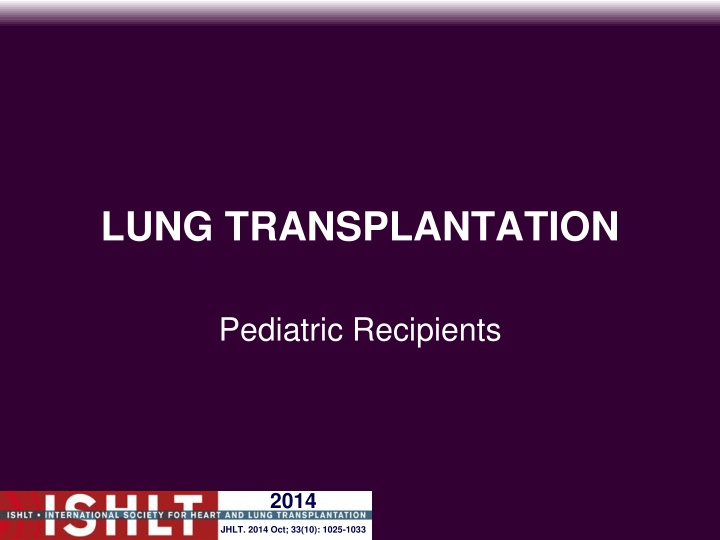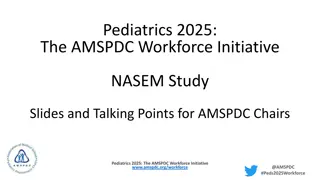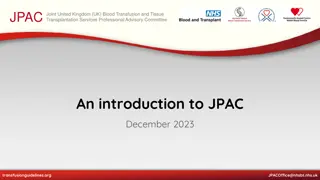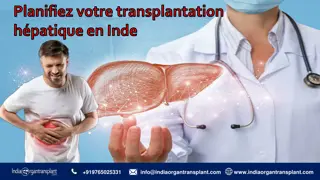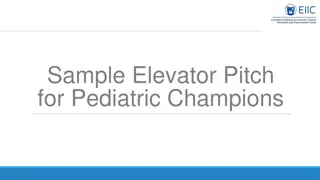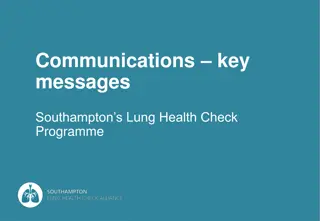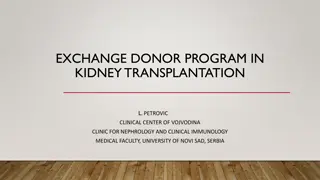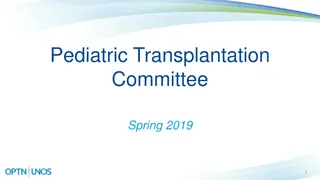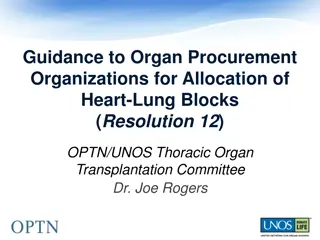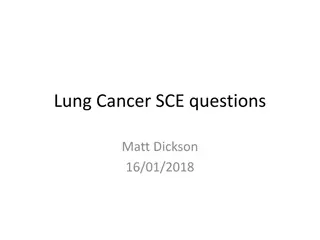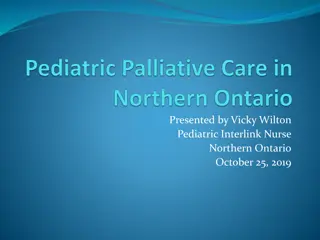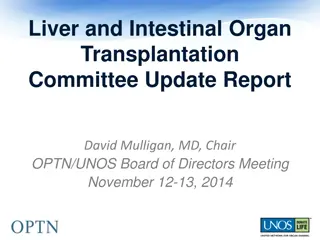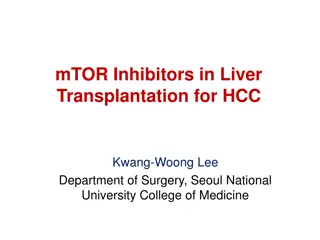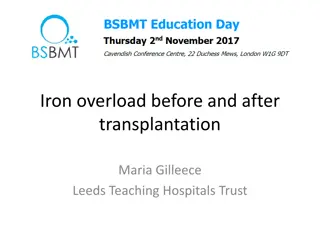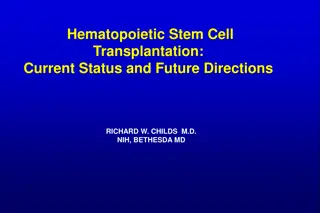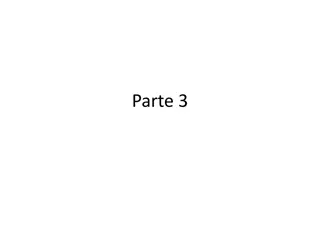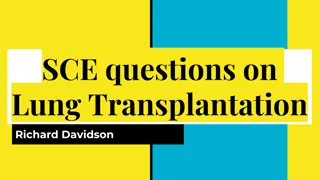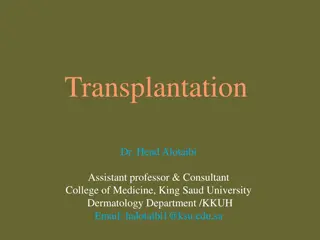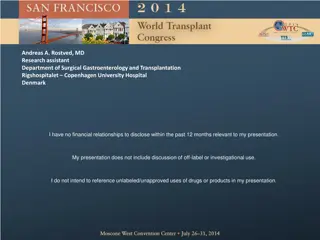Pediatric Lung Transplantation in 2014
Pediatric lung transplantation in 2014 encompassed various aspects such as donor, recipient, and center characteristics, post-transplant outcomes, immunosuppression, morbidities, and analyses. The data includes age distribution, donor type distribution by transplant year, and recipient age group distribution within eras.
Download Presentation

Please find below an Image/Link to download the presentation.
The content on the website is provided AS IS for your information and personal use only. It may not be sold, licensed, or shared on other websites without obtaining consent from the author.If you encounter any issues during the download, it is possible that the publisher has removed the file from their server.
You are allowed to download the files provided on this website for personal or commercial use, subject to the condition that they are used lawfully. All files are the property of their respective owners.
The content on the website is provided AS IS for your information and personal use only. It may not be sold, licensed, or shared on other websites without obtaining consent from the author.
E N D
Presentation Transcript
LUNG TRANSPLANTATION Pediatric Recipients 2014 JHLT. 2014 Oct; 33(10): 1025-1033
Table of Contents Donor, recipient and center characteristics: slides 3-18 Post transplant: survival and other outcomes: slides 19-36 Induction and maintenance immunosuppression: slides 37-43 Post transplant morbidities: slides 44-60 Multivariable analyses: slides 61-69 2014 JHLT. 2014 Oct; 33(10): 1025-1033
Donor, Recipient and Center Characteristics 2014 JHLT. 2014 Oct; 33(10): 1025-1033
Pediatric Lung Transplants Recipient Age Distribution Number (Transplants: January 1986 June 2013) 1,400 1,200 <1 1-5 6-10 11-17 Number of Transplants 1,000 800 600 400 200 0 1986-1999 (N=675) 2000-6/2012 (N=1,310) 2014 Analysis includes deceased and living donor transplants. JHLT. 2014 Oct; 33(10): 1025-1033
Pediatric Lung Transplants Recipient Age Distribution Percentage (Transplants: January 1986 June 2013) 100% 90% 80% % of Transplants 70% 11-17 60% 50% 6-10 40% 1-5 30% <1 20% 10% 0% 1986-1999 (N=675) 2000-6/2012 (N=1,310) 2014 Analysis includes deceased and living donor transplants. JHLT. 2014 Oct; 33(10): 1025-1033
Pediatric Lung Transplants Donor Type Distribution by Transplant Year (Transplants: January 1986 December 2012) 140 Living Deceased 120 Number of Transplants 100 80 60 40 20 0 NOTE: This figure includes only the lung transplants that are reported to the ISHLT Transplant Registry. As such, the presented data may not reflect the changes in the number of lung transplants performed worldwide. 2014 Analysis includes deceased and living donor transplants. JHLT. 2014 Oct; 33(10): 1025-1033
Pediatric Lung Transplants Donor Type Distribution by Recipient Age Group Within Era (Transplants: January 1986 June 2013) 1,200 Living Deceased 1,000 Number of Transplants 800 600 400 200 0 <1 year 1 - 5 years 6 - 10 years 11 - 17 years <1 year 1 - 5 years 6 - 10 years 11 - 17 years 1986-1999 2000-6/2013 Recipient Age 2014 Analysis includes deceased and living donor transplants. JHLT. 2014 Oct; 33(10): 1025-1033
Pediatric Lung Transplants Donor Age Distribution (Transplants: January 1986 June 2013) 100% 101 16 90% 245 80% 60+ years 324 70% 50 - 59 years % of Transplants 60% 35 - 49 years 455 50% 18 - 34 years 40% 11 - 17 years 30% 0 - 10 years 20% 695 10% 0% Donor Age (Years) 2014 JHLT. 2014 Oct; 33(10): 1025-1033
Pediatric Lung Transplants Donor and Recipient Age (Transplants: January 2000 June 2013) Donor Age: 0-10 years 11-17 years 18-34 years 35-49 years 50-59 years 60+ years 100% 80% % of Transplants 60% 40% 20% 0% <1 year 1 - 5 years Recipient Age 2014 6 - 10 years 11 - 17 years JHLT. 2014 Oct; 33(10): 1025-1033
Pediatric Lung Transplants Recipient Age Distribution by Year of Transplant 140 125126 11-17 years 6-10 years 1-5 years <1 year 120 114 103108 106 Number of Transplants 97 96 95 96 100 93 89 82 78 80 73 73 7274 60 4548 4952 40 23 20 7 5 3 1 0 NOTE: This figure includes only the pediatric lung transplants that are reported to the ISHLT Transplant Registry. Therefore, these numbers should not be interpreted as the rate of change in pediatric lung procedures performed worldwide. 2014 Analysis includes deceased and living donor transplants. JHLT. 2014 Oct; 33(10): 1025-1033
Pediatric Lung Retransplants by Year of Retransplant 12 24 N % 10 20 Number of retransplants % of retransplants 8 16 6 12 4 8 2 4 0 0 Year of retransplant Only patients who were less than 18 years old at the time of retransplant are included. 2014 JHLT. 2014 Oct; 33(10): 1025-1033
Pediatric Lung Transplants Number of Centers Reporting Transplants by Location (Transplants: January 1986 December 2012) 55 50 Others 45 North America Number of Centers 40 Europe 35 30 25 20 15 10 5 0 Transplant Year 2014 Analysis includes deceased and living donor transplants. JHLT. 2014 Oct; 33(10): 1025-1033
Pediatric Lung Transplants Number of Centers Reporting Transplants by Pediatric Center Volume 55 20+ transplants 10-19 transplants 5-9 transplants 1-4 transplants 50 45 40 Number of Centers 35 30 25 20 15 10 5 0 Transplant Year 2014 Analysis includes deceased and living donor transplants. JHLT. 2014 Oct; 33(10): 1025-1033
Pediatric Lung Transplants Number of Transplants by Pediatric Center Volume 140 20+ transplants 10-19 transplants 5-9 transplants 1-4 transplants 120 Number of Transplants 100 80 60 40 20 0 Transplant Year 2014 Analysis includes deceased and living donor transplants. JHLT. 2014 Oct; 33(10): 1025-1033
Pediatric Lung Transplants Indications by Age Group (Transplants: January 1990 June 2013) Diagnosis Cystic Fibrosis Idiopathic Pulmonary Arterial Hypertension Retransplant: Obliterative Bronchiolitis Congenital Heart Disease Idiopathic Pulmonary Fibrosis Obliterative Bronchiolitis, Not Retx Retransplant, Not OB Interstitial Pneumonitis Pulmonary Vascular Disease < 1 Year 1-5 Years 6-10 Years 11-17 Years 1 1.0% 6 4.5% 148 52.3% 968 69.7% 12 12.1% 30 22.6% 26 9.2% 109 7.8% 0 7 5.3% 9 3.2% 40 2.9% 16 16.2% 11 8.3% 4 1.4% 12 0.9% 10 10.1% 21 15.8% 16 5.7% 47 3.4% 0 10 7.5% 23 8.1% 58 4.2% 3 3.0% 4 3.0% 8 2.8% 37 2.7% 1 1.0% 2 1.5% 2 0.7% 1 0.1% 8 8.1% 8 6.0% 4 1.4% 1 0.1% Eisenmenger s Syndrome 1 1.0% 5 3.8% 3 1.1% 9 0.6% Pulmonary Fibrosis, Other Surfactant Protein B Deficiency COPD/Emphysema Bronchopulmonary Dysplasia Bronchiectasis Other 8 8.1% 12 9.0% 15 5.3% 28 2.0% 17 17.2% 5 3.8% 0 0 4 4.0% 2 1.5% 2 0.7% 10 0.7% 3 3.0% 3 2.3% 6 2.1% 3 0.2% 1 1.0% 0 2 0.7% 18 1.3% 14 14.1% 7 5.3% 15 5.3% 48 3.5% Analysis includes deceased and living donor transplants. For some retransplants diagnosis other than retransplant is reported, so the total percentage of retransplants may be greater. 2014 JHLT. 2014 Oct; 33(10): 1025-1033
Pediatric Lung Transplants Age Distribution by Location (Transplants: January 2000 June 2013) <1 year 1 - 5 years 6 - 10 years 11 - 17 years 100% 80% % of Transplants 60% 40% 20% 0% Europe (N=512) North America (N=712) Other (N=86) 2014 Analysis includes deceased and living donor transplants. JHLT. 2014 Oct; 33(10): 1025-1033
Pediatric Lung Transplants Diagnosis Distribution by Location (Transplants: January 2000 June 2013) Cystic Fibrosis IPAH IPF OB Other Congenital heart disease Retx 100% 80% % of Transplants 60% 40% 20% 0% Europe (N=485) North America (N=711) Other (N=85) Total number of transplants reported: Europe = 512 North America = 712 Other = 86 For some retransplants diagnosis other than retransplant is reported, so the total percentage of retransplants may be greater. 2014 NOTE: Unknown diagnoses were excluded from this tabulation. Analysis includes deceased and living donor transplants. JHLT. 2014 Oct; 33(10): 1025-1033
Pediatric Lung Transplants Donor Age Distribution by Location (Transplants: January 2000 June 2013) 0 - 10 years 11 - 17 years 18 - 34 years 35 - 49 years 50 - 59 years 60+ years 100% 80% % of Donors 60% 40% 20% 0% Europe (N=505) North America (N=676) Other (N=77) NOTE: Transplants with unknown donor age and living donor transplants were excluded from this tabulation. Total number of transplants reported: Europe = 512 North America = 712 Other = 86 JHLT. 2014 Oct; 33(10): 1025-1033 2014
Post Transplant: Survival and Other Outcomes 2014 JHLT. 2014 Oct; 33(10): 1025-1033
Lung Transplants Kaplan-Meier Survival by Recipient Age Group (Transplants: January 1990 June 2012) 100 Adult (N=43,501) Pediatric (N=1,751) 75 Survival (%) p = 0.4400 50 25 Median survival (years): Adult = 5.6; Pediatric = 5.1 0 0 1 2 3 4 5 6 7 8 9 10 11 12 13 14 15 16 17 18 Years 2014 JHLT. 2014 Oct; 33(10): 1025-1033
Lung Transplants Kaplan-Meier Survival by Recipient Age Group and Procedure Type (Transplants: January 1990 June 2012) 100 Adult, Single (N=17,295) Adult, Bilateral/Double (N=26,175) Pediatric (N=1,751) 75 Adult, Bilateral/ Double vs. Adult, Single: p<0.0001 Adult, Bilateral/ Double vs. Pediatric: p=0.0003 Adult, Single vs. Pediatric: p<0.0001 Survival (%) 50 25 Median survival (years): Adult, Single = 4.5; Adult, Bilateral/Double = 7.0; Pediatric = 5.1 0 0 1 2 3 4 5 6 7 8 Years 9 10 11 12 13 14 15 16 17 2014 JHLT. 2014 Oct; 33(10): 1025-1033
Pediatric Lung Transplants Kaplan-Meier Survival by Procedure Type (Transplants: January 1990 June 2012) 100 Single Lung (N=94) Bilateral/Double Lung (N=1,654) 75 Survival (%) p<0.0001 50 25 Median survival (years): Single Lung = 1.9; Bilateral/Double Lung = 5.5 0 0 1 2 3 4 5 6 7 Years 8 9 10 11 12 13 14 15 2014 JHLT. 2014 Oct; 33(10): 1025-1033
Pediatric Lung Transplants Kaplan-Meier Survival by Diagnosis (Transplants: January 1990 June 2012) 100 Cystic Fibrosis (N=985) Non-Cystic Fibrosis (N=706) 75 p=0.6070 Survival (%) 50 25 Median survival (years): Cystic Fibrosis = 4.9; Non-Cystic Fibrosis = 5.1 0 0 1 2 3 4 5 6 7 8 Years 9 10 11 12 13 14 15 16 17 2014 JHLT. 2014 Oct; 33(10): 1025-1033
Pediatric Lung Transplants Kaplan-Meier Survival by Recipient Age Group (Transplants: January 1990 June 2012) 100 <1 Year (N=99) 1-5 years (N=129) 6-10 years (N=257) 11-17 years (N=1,266) Pair-wise comparisons were not significant at p<0.05. 75 Survival (%) 50 N at risk = 10 Median survival (years): <1 year = 6.4 1-5 years = 6.7 6-10 years = 6.5 11-17 years = 4.7 N at risk = 17 N at risk = 11 25 N at risk = 25 0 0 1 2 3 4 5 6 7 8 9 10 11 12 13 14 15 16 Years 2014 JHLT. 2014 Oct; 33(10): 1025-1033
Pediatric Lung Transplants Conditional Kaplan-Meier Survival by Recipient Age Group (Transplants: January 1990 June 2012) 100 <1 year (N=63) 1-5 years (N=90) 6-10 years (N=199) 11-17 years (N=933) Pair-wise comparisons were not significant at p<0.05. 75 Survival (%) N at risk = 11 N at risk = 10 50 N at risk = 17 Conditional median survival (years): <1 year = 11.2 1-5 years = 10.5 6-10 years = 9.7 11-17 years = 7.7 N at risk = 25 25 0 0 1 2 3 4 5 6 7 8 9 10 11 12 13 14 15 16 Years 2014 JHLT. 2014 Oct; 33(10): 1025-1033
Pediatric Lung Transplants Kaplan-Meier Survival by Era (Transplants: January 1988 June 2012) 100 Median survival (years): Unconditional 1988-1999=3.3; 2000-2005=6.1; 2006-6/2012=5.6 Conditional 1988-1999=7.2; 2000-2005=9.0; 2006-6/2012=7.0 75 1988-1999 vs. 2000-2005: p=0.004 1988-1999 vs. 2006-6/2012: p<0.0001 2000-2005 vs. 2006-6/2012 is not significant at p<0.05. Survival (%) N at risk = 12 50 N at risk = 14 25 1988-1999 (N=602) 2000-2005 (N=446) 2006-6/2012 (N=715) N at risk = 40 0 0 1 2 3 4 5 6 7 8 9 10 11 12 13 14 15 16 Years 2014 JHLT. 2014 Oct; 33(10): 1025-1033
Pediatric Lung Transplants Kaplan-Meier Survival by Donor Age for Recipients Age 11-17 Years (Transplants: January 1990 June 2012) 100 Median survival (years): 0-10 years=5.4 11-17 years=4.7 18-34 years=4.7 35-49 years=4.4 50+ years=3.9 No pair-wise comparisons were significant at p<0.05. 75 Survival (%) 50 N at risk = 12 N at risk = 12 0-10 years (N=243) 11-17 years (N=400) 18-34 years (N=284) 35-49 years (N=215) 50+ years (N=105) N at risk = 11 25 N at risk = 10 N at risk = 11 0 0 1 2 3 4 5 6 7 8 9 10 11 12 13 14 15 16 Years 2014 JHLT. 2014 Oct; 33(10): 1025-1033
Pediatric Lung Transplants Kaplan-Meier Survival by Donor Type for Recipients Age 11-17 Years (Transplants: January 1990 June 2012) 100 Median survival (years): Deceased = 4.7 Living = 3.8 75 Survival (%) p = 0.1743 50 N at risk = 25 25 N at risk = 10 Deceased Donor (N=1,266) Living Donor (N=85) 0 0 1 2 3 4 5 6 7 8 9 10 11 12 13 14 15 16 Years 2014 JHLT. 2014 Oct; 33(10): 1025-1033
Pediatric Lung Transplants Kaplan-Meier Survival for Living Donor Transplant Recipients Age 11-17 Years by Era (Transplants: January 1990 June 2012) 100 p = 0.8516 75 Survival (%) 50 N at risk = 16 N at risk = 11 25 1990-1999 (N=49) 2000-6/2012 (N=36) 0 0 1 2 3 4 5 6 Years 2014 JHLT. 2014 Oct; 33(10): 1025-1033
Pediatric Lung Retransplants (Retransplants: January 1994 June 2013) 45 40 Number of Retransplants 35 30 25 20 15 10 5 0 0-<1 month 1-<12 months 12-<36 months 36+ months Not reported Time Between Previous and Current Transplant 2014 Analysis includes deceased and living donor transplants. JHLT. 2014 Oct; 33(10): 1025-1033
Pediatric Lung Transplants Kaplan-Meier Survival by Transplant Type (Transplants: January 1994 June 2012) 100 Retransplant (N = 106) Primary (N = 1,490) 80 p<0.0001 Survival (%) 60 N at risk = 246 40 N at risk = 15 20 0 0 1 2 3 4 5 6 7 Years 2014 JHLT. 2014 Oct; 33(10): 1025-1033
Pediatric Lung Transplants Survival by Transplant Type and Inter-Transplant Interval (Transplants: January 1988 June 2012) 100 Retransplant/<1 Year (N=34) Retransplant/ 1 Year (N=82) Primary (N=1,743) 80 Survival (%) 60 N at risk = 388 40 N at risk = 11 N at risk = 15 20 Retransplant/<1 Year vs. Primary: p<0.0001 Retransplant/ 1 Year vs. Primary: p=0.0007 Retransplant/<1 Year vs. Retransplant/ 1 year is not significant at p<0.05. 0 0 1 2 3 4 5 6 Analysis includes deceased and living donor transplants. Only patients who were less than 18 years old at the time of retransplant are included. Years 2014 JHLT. 2014 Oct; 33(10): 1025-1033
Pediatric Lung Retransplants Survival by Diagnosis (Transplants: January 1988 June 2012) 100 80 p = 0.8740 Survival (%) 60 N at risk = 13 40 N at risk = 10 Obliterative Bronchiolitis (N=60) 20 Non Obliterative Bronchiolitis (N=66) 0 0 1 2 3 4 5 6 Years Analysis includes deceased and living donor transplants. Only patients who were less than 18 years old at the time of retransplant are included. 2014 JHLT. 2014 Oct; 33(10): 1025-1033
Pediatric Lung Transplants Functional Status of Surviving Recipients (Follow-ups: March 2005 June 2013) 100% 10% 20% 80% 30% 40% 60% 50% 60% 40% 70% 80% 20% 90% 100% 0% 3 Years (N=251) 1 Year (N=368) 2 Years (N=308) 2014 JHLT. 2014 Oct; 33(10): 1025-1033
Pediatric Lung Transplants Rehospitalization Post-transplant of Surviving Recipients (Follow-ups: April 1994 June 2013) 100% 80% 60% 40% No Hospitalization Hospitalized, Rejection Hospitalized, Rejection + Infection Hospitalized, Not Rejection/Not Infection Hospitalized, Infection Only 20% 0% Up to 1 Year (N=786) Between 2 and 3 Years (N=489) Between 4 and 5 Years (N=299) 2014 JHLT. 2014 Oct; 33(10): 1025-1033
Pediatric Lung Transplants Rehospitalization Post-transplant of Surviving Recipients (Follow-ups: April 1994 June 2013) 100% 80% 60% 40% No Hospitalization Hospitalized, Rejection Hospitalized, Rejection + Infection Hospitalized, Not Rejection/Not Infection Hospitalized, Infection Only 20% 0% Up to 1 Year (N=786) Between 1 and 3 Years (N=440) Between 3 and 5 Years (N=269) 2014 JHLT. 2014 Oct; 33(10): 1025-1033
Induction and Maintenance Immunosuppression 2014 JHLT. 2014 Oct; 33(10): 1025-1033
Pediatric Lung Transplants Induction Immunosuppression (Transplants: January 2001 June 2013) 70 60 50 % of patients 40 30 20 10 0 Any Induction (N = 406) Polyclonal ALG/ATG (N = 87) IL-2R Antagonist (N = 315) Analysis is limited to patients who were alive at the time of the discharge. 2014 JHLT. 2014 Oct; 33(10): 1025-1033
Pediatric Lung Transplants Induction Immunosuppression (Transplants: January 2001 June 2013) 80 70 60 % of patients 50 40 30 20 10 0 Any Induction Polyclonal ALG/ATG IL-2R Antagonist Analysis is limited to patients who were alive at the time of the discharge. 2014 JHLT. 2014 Oct; 33(10): 1025-1033
Pediatric Lung Transplants Kaplan-Meier Survival Stratified by Induction Use (Transplants: January 2001 June 2012) 100 Median survival (years): Induction = 6.5 No Induction = 6.1 75 p=0.8870 Survival (%) 50 25 Induction (N = 370) No Induction (N = 227) 0 0 1 2 3 4 5 6 7 Years 2014 JHLT. 2014 Oct; 33(10): 1025-1033
Pediatric Lung Transplants Maintenance Immunosuppression at Time of Follow-up (Follow-ups: January 2001 June 2013) 100 Year 1 (N = 495) Year 5 (N = 230) 80 % of patients 60 40 20 0 Cyclosporine Tacrolimus Sirolimus/ Everolimus MMF/MPA Azathioprine Prednisone NOTE: Different patients are analyzed in Year 1 and Year 5. 2014 Analysis is limited to patients who were alive at the time of the follow-up. JHLT. 2014 Oct; 33(10): 1025-1033
Pediatric Lung Transplants Maintenance Immunosuppression at Time of Follow-up (Follow-ups: January 2001 June 2013) 100 80 % of Patients 60 MMF/ MPA Tac MMF/ MPA Tac 40 20 CyA CyA AZA AZA 0 Calcineurin Inhibitor 1 Year Follow-up (N = 495) CellCycle Prednisone Calcineurin Inhibitor 5 Year Follow-up (N = 230) CellCycle Prednisone NOTE: 0.2% of patients were on both calcineurin inhibitors at different point during the 1-year; these patients are not counted in either group. And no patients were on neither drug during the 1-year. In the 5-year tabulations, 0.4% were reported to be on both drugs during the year and 0.9% (2 patients) was reported to be on neither drugs. 2014 NOTE: Different patients are analyzed in Year 1 and Year 5. Analysis is limited to patients who were alive at the time of the follow-up. JHLT. 2014 Oct; 33(10): 1025-1033
Pediatric Lung Transplants Maintenance Immunosuppression Drug Combinations at Time of Follow-up (Follow-ups: January 2001 June 2013) 100% Other 80% Tacrolimus + Sirolimus/Everolimus % of Patients Tacrolimus 60% Tacrolimus + MMF/MPA 40% Tacrolimus + AZA Cyclosporine + MMF/MPA 20% Cyclosporine + AZA 0% Year 1 (N = 495) NOTE: Different patients are analyzed in Year 1 and Year 5. Year 5 (N = 230) Analysis is limited to patients who were alive at the time of the follow-up. 2014 JHLT. 2014 Oct; 33(10): 1025-1033
Post Transplant Morbidities 2014 JHLT. 2014 Oct; 33(10): 1025-1033
Pediatric Lung Transplants Cumulative Morbidity Rates in Survivors within 1 Year Post-Transplant (Follow-ups: April 1994 June 2013) Within 1 Year Total number with known response Outcome 40.9% (N = 727) Hypertension 9.4% (N = 756) Renal Dysfunction 6.3% Abnormal Creatinine 2.5 mg/dl 2.0% Creatinine > 2.5 mg/dl 0.8% Chronic Dialysis 0.3% Renal Transplant 5.0% (N = 746) Hyperlipidemia 22.2% (N = 757) Diabetes 12.9% (N = 700) Bronchiolitis Obliterans Syndrome 2014 JHLT. 2014 Oct; 33(10): 1025-1033
Pediatric Lung Transplants Cumulative Morbidity Rates in Survivors within 1 Year Post- Transplant by Induction Use (Transplants: January 2000 June 2012) Induction Total number with known response 43.6% No Induction Total number with known response 43.1% Outcome Within 1 Year Within 1 Year (N = 319) (N = 181) Hypertension 10.9% (N = 330) 9.7% (N = 196) Renal Dysfunction 8.2% 6.6% Abnormal Creatinine 2.5 mg/dl 2.1% 2.0% Creatinine > 2.5 mg/dl 0.6% 0.5% Chronic Dialysis 0% 0.5% Renal Transplant 5.2% (N = 328) 9.8% (N = 183) Hyperlipidemia 22.1% (N = 330) 26.9% (N = 197) Diabetes 12.2% (N = 311) 9.9% (N = 181) Bronchiolitis Obliterans Syndrome 2014 JHLT. 2014 Oct; 33(10): 1025-1033
Pediatric Lung Transplants Cumulative Morbidity Rates in Survivors within 5 Years Post-Transplant (Follow-ups: April 1994 June 2013) Within 5 Years Total number with known response Outcome 69.0% (N = 210) Hypertension 31.3% (N = 224) Renal Dysfunction 24.1% Abnormal Creatinine 2.5 mg/dl 4.5% Creatinine > 2.5 mg/dl 1.8% Chronic Dialysis 0.9% Renal Transplant 17.8% (N = 214) Hyperlipidemia 35.7% (N = 224) Diabetes 35.5% (N = 172) Bronchiolitis Obliterans Syndrome 2014 JHLT. 2014 Oct; 33(10): 1025-1033
Pediatric Lung Transplants Cumulative Morbidity Rates in Survivors within 5 Years Post- Transplant by Induction Use (Transplants: January 2000 June 2008) Induction Total number with known response 75.0% No Induction Total number with known response 61.7% Outcome Within 5 Years Within 5 Years (N = 68) (N = 60) Hypertension 30.3% (N = 76) 35.4% (N = 65) Renal Dysfunction 28.9% 29.2% Abnormal Creatinine 2.5 mg/dl 1.3% 1.5% Creatinine > 2.5 mg/dl 0% 4.6% Chronic Dialysis 0% 0% Renal Transplant 29.6% (N = 71) 20.7% (N = 58) Hyperlipidemia 41.6% (N = 77) 35.9% (N = 64) Diabetes 30.2% (N = 63) 46.0% (N = 50) Bronchiolitis Obliterans Syndrome 2014 JHLT. 2014 Oct; 33(10): 1025-1033
Pediatric Lung Transplants Cumulative Morbidity Rates in Survivors within 7 Years Post- Transplant (Follow-ups: April 1994 June 2013) Within 7 Years Total number with known response Outcome 44.0% (N = 125) Renal Dysfunction 33.6% Abnormal Creatinine 2.5 mg/dl 6.4% Creatinine > 2.5 mg/dl 0.8% Chronic Dialysis 3.2% Renal Transplant 42.0% (N = 81) Bronchiolitis Obliterans Syndrome 2014 JHLT. 2014 Oct; 33(10): 1025-1033
Pediatric Lung Transplants Freedom from Bronchiolitis Obliterans Syndrome (Follow-ups: April 1994 June 2013) 100 90 % Free from Bronchiolitis 80 Obliterans Syndrome 70 60 50 40 30 20 10 0 0 1 2 3 4 5 6 7 8 9 Years 2014 JHLT. 2014 Oct; 33(10): 1025-1033
